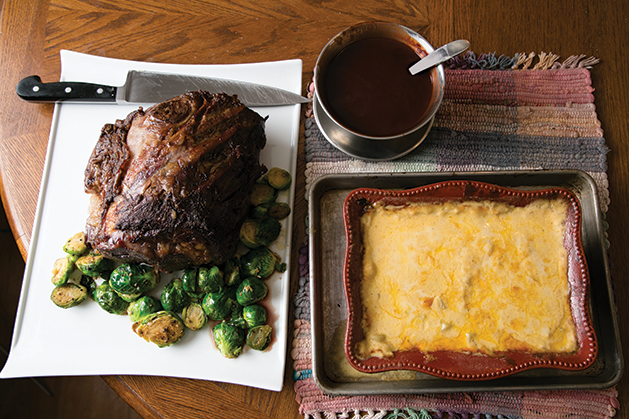
Greg Knothe hasn’t always been a French-trained chef, but he’s always enjoyed making good food. In 2004, after working as a machinist for many years, Knothe left the world of manufacturing to pursue a long-time love—cooking.
Knothe says, “One day, I was watching Iron Chef America with some friends, and someone said, ‘Greg, you should culinary school!’” The idea stuck, and Knothe enrolled in an 18-month program at Le Cordon Bleu in Minneapolis (since closed). Knothe is now Chef Greg, proprietor of Personal Chef Greg’s In-Home Cuisine & Catering in White Bear Lake.
Knothe has catered weddings, graduation parties and many other types of events. His favorite events are dinner parties. “They’re more intimate,” he says. “You can do more with them.”
What kind of food does Knothe most enjoy cooking? “Meat,” he says. “Especially in the winter, but really any time. Roast or prime rib with a port-wine reduction. Lamb. Everyone thinks lamb is so hard to cook, but it’s just like cooking beef. You have to pay attention to it, but you should be paying attention anyway. And barbecue.” He is also fond of popular Italian foods such as lasagna, and dishes with Alfredo or Bolognese sauces. Knothe buys his meat at Costco--he says it’s top quality at a good price.
Knothe prepares vegetarian meals as well, but not of his own volition. Some of his favorite veggie dishes to prepare are spaghetti squash with marinara sauce and lasagna prepared with mushrooms and/or zucchini in place of meat.
Knothe sometimes prepares desserts, but jokingly says, “You’re not gonna get a three-tiered cake out of me.” When clients request gluten-free desserts, Knothe often prepares flourless chocolate cake, fruit cobbler or some type of custard like crème brulee. Knothe makes his own ice cream. His favorite? “The classic—vanilla. It’s the flavor that clients ask for the most. And French silk pie is another favorite. His secret? “Beat the eggs to death,” he says. “The more you beat it, the fluffier it gets.”
Knothe has noticed a definite change in the type of food available locally. “The Twin Cities is getting much better with herbs and spices,” he says. “It’s not all bland food anymore. I grew up with salt and pepper on a chicken breast, and that was the extent of it,” says Knothe. “There are still foods that people are afraid to try, but it’s getting much better.”
In addition to catering, Knothe also teaches cooking. He’s taught classes in Chisago schools’ adult education program, as well as White Bear Lake adult education. Some of his course offerings are Italian cooking, Thanksgiving side dishes, desserts, spices, soups, appetizers, and classes focusing on technique, such as a course on how to roast, braise and sauté, which Knothe especially enjoys teaching. “Learning technique is better than learning recipes,” says Knothe. “If you learn technique, you can make your own recipes.”
Knothe’s advice for home cooks who want to up their game?
Play with your food—have fun when you cook and pick flavors you like.
Don’t overdo things—keep it simple. Don’t overthink. “You don’t need 50 ingredients in a dish. Buy quality ingredients and let the ingredients speak for themselves.
It’s great if you can think of cooking as fun and relaxing—a way to de-stress from your day instead of a dreaded task. Learn how to braise and learn how to roast and you should be able to get through almost any dish.
Chef Greg’s Aged Standing Rib Roast
If you really like meat, this recipe is for you. With a lead time of two weeks, it’s a good choice for a special occasion for the devoted carnivores in your life. And Chef Greg says, “It’s the easiest thing ever.”
Servings: About 10
“Aging” time: 2 weeks
Additional time: About 3 hours
Active time: About 1 hour
Ingredients
Standing rib roast,
about 6 pounds
4 medium or 3 large
onions, coarsely chopped
3 stalks celery, cut into
about 2-inch pieces
3 large carrots, cut into
about 2-inch pieces
Olive oil
Salt
Fresh ground pepper
Few springs thyme
1 bay leaf
1-2 garlic cloves (optional)
Beef or chicken stock, red wine, brandy or any combination amounting to about 3 cups. (If using stock, homemade is best, but if you’re buying pre-made, Chef Greg recommends Kirkland’s organic chicken stock, available at Costco, or Kitchen Basics, available at many supermarkets.
Preparing the Meat
If frozen, bring to room temperature.
Remove all packaging and place, uncovered, on the bottom shelf of the refrigerator. Do not trim off the fat. You can place it on the tray it came in, or on a plate with paper towels. Every other day, turn the meat so that the entire roast gets exposed to air. After two weeks, when you’re ready to cook it, remove from fridge.
Roasting the Meat
Preheat oven to 300 F. With a paring knife, scrape off the hard, dried outer layer of the meat and discard. Place meat on the counter until it comes to room temperature, about 1 to 1½ hours.
In a heavy, non-reactive (such as Calphalon) roasting pan, place onions, celery and carrots. (Do not use a non-stick pan for this recipe.)
When meat has reached room temperature, place in the roasting pan on top of the chopped vegetables. Rub meat with olive oil so that the entire surface is covered with oil. [Chef Greg says “Massage it good into the meat.”] Salt and pepper liberally. Add 2-3 cups stock or water, or a combination, to roasting pan
Place into the preheated oven. (Do not cover.) For medium-rare, roast until meat is at 130 degrees on the meat thermometer, about 2-3 hours.
Remove meat from roasting pan and place on a plate. Cover loosely with aluminum foil. (Don’t cover too tightly—if it’s covered too tightly it will “steam” the meat—leading to an unpleasant taste and texture.) Allow meat to rest for 30 minutes before serving (It will smell so good that it will be tempting to eat it right away, but it’s important to let it rest so that the juices don’t pour out when slicing.)
Making the Deglazing Sauce
Remove the vegetables and fat from the pan and discard. (You don’t have to remove all the fat.) While the meat is resting, place the roasting pan on the stovetop on medium heat. With a whisk or spoon, scrape off the bits of meat that are stuck to the bottom of the pan. Then add the stock, wine, brandy or combination, while continuing to scrape any bits still sticking to the bottom. Bring to a low boil. Add thyme, bay leaf and garlic if using. Continue to simmer until the liquid is reduced to about half its volume and is almost syrupy in texture. (If the liquid coats the back of a spoon, it’s ready.) Remove from heat. Remove thyme, bay leaf and optional garlic. Slice meat and pour sauce over it, or serve on the side.
Serve with boiled new potatoes and veggie of your choice, and you will have some very happy eaters.
Food safety note: If you’re aging beef, be sure to get a refrigerator thermometer and be sure your fridge is set below 40°F.









